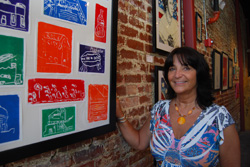Editorial
Front Page - Friday, October 22, 2010
Gallery of artwork by homeless artists opens on Main Street
David Laprad

Imagine a world in which Picasso had never picked up a paintbrush, Shakespeare had never picked up a pen and Mozart had never sat down at a clavier. In the realms of art, literature and music, wasted potential is tragic.
Now picture a world in which a homeless man sees the moon dipping behind Lookout Mountain as he rests under a blanket of stars. He has the soul of an artist, but no paintbrush or paints with which to preserve the scene.
Fortunately, Picasso, Shake-speare and Mozart blessed the world with their works of genius. The homeless man was able to entrust his memory to canvas, too. His painting is currently on display at Hart Gallery Tennessee, which provided the materials he used to create the piece.
Located on Main Street, Hart Gallery is an art education program that supplies materials and mentoring to other community organizations, which in turn provide a space for their clients to create works of art that will be sold through the gallery at affordable prices. Founder and Executive Director Ellen Heavilon says she wanted to provide a way for homeless people to use their creativity to earn money.
“We don’t believe in handouts. There’s a cost to us to put an artist’s work on display, so he has to contribute to the process,” she says.
If an artist must suffer for his or her work, then the men and women creating pieces for sale through Hart Gallery are being molded as future Rembrandts. Most are homeless, and most come in contact with the gallery through the Chattanooga Community Kitchen. Among the artists is a victim of domestic violence, a cancer survivor and a man who lives in a wooded area and skates between varying degrees of mental stability.
But Heavilon doesn’t judge. Instead, she sees talented and creative people who are no different from anyone else.
“Homelessness is not a personality trait; it’s a living condition. Sometimes it’s temporary; sometimes it’s chosen. Circumstances have led certain people to that place in life, but it doesn’t make other people better than them.”
The artwork in her gallery hangs in silent agreement. Watercolors of exquisite beauty share space with skillfully rendered impressionistic landscapes; handmade jewelry, dream catchers and a pottery holder occupy a spacious shelf near the gallery’s entrance; emotionally expressive pencil and pen sketches cover three portable walls; and a cluster of wildly imaginative avant guarde pieces inhabits an expansive portion of the room’s chic brick and mortar enclosure.
The doors of the gallery are open to the public Wednesdays through Fridays from 11 a.m. to 6 p.m. and Saturdays from 10 a.m. to 2 p.m. The idea, Heavilon says, is to allow the work of people who are largely invisible to be seen.
“When you are seen, you feel like you matter, and when you feel like you matter, you become accountable, which leads to responsibility,” she says.
Feeling like one matters can also bring about changes in outlook. Heavilon points out a series of sketches by an artist who learned to draw while in prison. The first few pieces the man submitted to the gallery were stark black and white drawings packed with skulls and other spine-chilling elements. His later pieces, however, incorporate dazzling bursts of color and more serene imagery.
“I believe that has something to do with what’s taking
place inside him,” Heavilon says.
Heavilon’s other purpose in opening the gallery was to create a venue through which affordable art could be made available to everyone. Prices for original artwork range from $15 to $200; prints of some pieces are available for substantially less. Heavilon pays the artist 60 percent of the proceeds of each sale and the organization 10 percent. The rest helps to cover the costs of running the gallery.
“After the Downtown Gall-ery Hop in September, I wrote checks to nine artists and three organizations,” Heavilon says.
The moment of inspiration
for Hart Gallery came as Heav-ilon and her husband, Jay, were walking along Main Street and came across an obelisk covered with drawings and inscriptions by homeless people.
“Being homeless is hard. I miss having a bed, my family and feeling loved,” read one tile.
Heavilon’s husband asked her if she could sell artwork like the homeless people had created, to which she replied yes. As they looked at the empty buildings undergoing renovation around them, the idea for the gallery clicked into place.
Today, artwork by people who own nothing more than the clothes on their backs, and the skills that enable them to create their own masterpieces, are available for everyone to enjoy and purchase.
“My husband and I get such joy from art. We love looking
at it and collecting it. Some-times it makes us laugh; other times, it makes us think. It’s our pleasure to share this experience with others.”
|
|